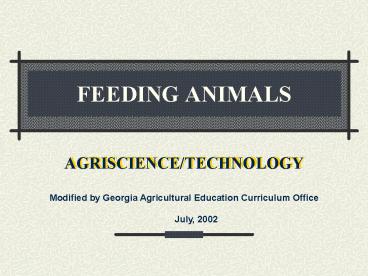FEEDING ANIMALS - PowerPoint PPT Presentation
1 / 17
Title:
FEEDING ANIMALS
Description:
FATS: Meat scraps, tankage, cottonseed and fish meal are examples. PROTEIN: Tankage, soybean meal, legume hay, blood meal, feather meal, fish meal and skim milk. ... – PowerPoint PPT presentation
Number of Views:58
Avg rating:3.0/5.0
Title: FEEDING ANIMALS
1
FEEDING ANIMALS
- AGRISCIENCE/TECHNOLOGY
Modified by Georgia Agricultural Education
Curriculum Office
July, 2002
2
REASONS WHY ANIMALS NEED FEED
- MAINTENANCE
- GROWTH
- REPRODUCTION
- LACTATION
- WORKING
- OTHER PRODUCTS AND USES
3
WAYS ANIMALS USE NUTRIENTS TO MAINTAIN THEMSELVES
- Used to keep the body warm
- Replace old cells
- Run the internal organs
- For body movement
4
SIX TYPES OF MATERIALS THAT PROVIDE NUTRIENTS
- CARBOHYDRATES Major sources are corn, oats, hay,
soybean oil meal and grain sorghum. - FATS Meat scraps, tankage, cottonseed and fish
meal are examples. - PROTEIN Tankage, soybean meal, legume hay, blood
meal, feather meal, fish meal and skim milk.
5
TYPES OF MATERIALS (CONT.)
- MINERALS Eighteen minerals are needed by
animalssix are macrominerals. Includes calcium,
salt, phosphorus, magnesium, potassium and
sulfur. - VITAMINS Vitamins A,D, and the B vitamins are
most important in animals. - WATER Most important of all nutrients. A market
hog is 40 water newborn calf is 70 water.
6
TWO GENERAL CLASSES OF FEEDSTUFFS
- ROUGHAGES Feedstuffs that are high in fiber and
low in energy. - Examples include hay, green pasture grasses and
legumes and silage. - CONCENTRATES Feed that are low in fiber and high
in energy. - Examples are corn, oats, wheat, meat scraps,
blood meal, soybean meal and urea.
7
DIGESTIBLE NUTRIENT
- A digestible nutrient is the part of a feedstuff
that can be digested, or broken down. - Fiber in roughage is not easily digested.
- Ruminants and horses are efficient users of
roughage.
8
TERMS
- RATION The total amount of feed an animal gets
in a 24 hour period. - BALANCED RATION A ration that provides all of
the nutrients needed by the animal in the right
amount and proportion. - DIET Type and amount of feed and water an animal
eats.
9
THREE TYPES OF ROUGHAGE FOR ANIMALS
- PASTURE- Land where grasses and other plants grow
for animals to graze. - HAY- Made of the leaves and stems of plants that
have been cut and dried for feed. - SILAGE- Made from cut green plants by chopping
them into small pieces and placing the chop in
a silo.
10
EXAMPLES OF GRAIN CONCENTRATES
- Grains are high in TDN but do not provide a
balanced ration. - Examples include corn, oats, wheat and grain
sorghum. - Corn is the most widely used grain.
11
SOURCES OF PROTEIN SUPPLEMENTS
- Protein supplements are high in TDN and high in
protein. - Three types
- Animal - meat scraps and tankage, blood meal,
fish meal, and skim milk. - Plant- soybean oil meal, cotton seed meal and
various grain by-products. - Synthetic- Urea, molasses, rice hulls, and citrus
pulp treated with ammonia.
12
FEED ADDITIVES
- Placed in feed while it is being manufactured to
preserve it and enhance growth of the animals. - Medications
- Wormers
- Marketing enhancement
- Antioxidants
13
IMPLANTS AND INJECTIONS
- Implants involve placing solid materials under
the skin. - Injections involve using hypodermic needles and
syringes to get a substance into the body system
of an animal. - Examples are BST to increase milk production in
dairy cows and fish may be injected to encourage
spawning.
14
FACTORS TO CONSIDER IN SELECTING FEED FOR ANIMALS
- NUTRIENT CONTENT
- PALATABILITY
- FREE OF HAZARDOUS MATERIALS
- VARIETY
- BULKINESS
- COST
- FEED STORAGE
15
THREE FORMS IN WHICH ROUGHAGE IS FED
- BALES
- LOOSE CHOP
- PELLETS AND WAFERS
16
WAYS CONCENTRATES ARE MADE INTO FORMS OF FEED
- CRACKING AND ROLLING
- GRINDING
- EXTRUDING
17
WAYS SUPPLEMENTS ARE PREPARED
- BLOCKS- Salt or mineral block
- LIQUIDS- Molasses
- MIXES- Salt, protein sources and other materials































